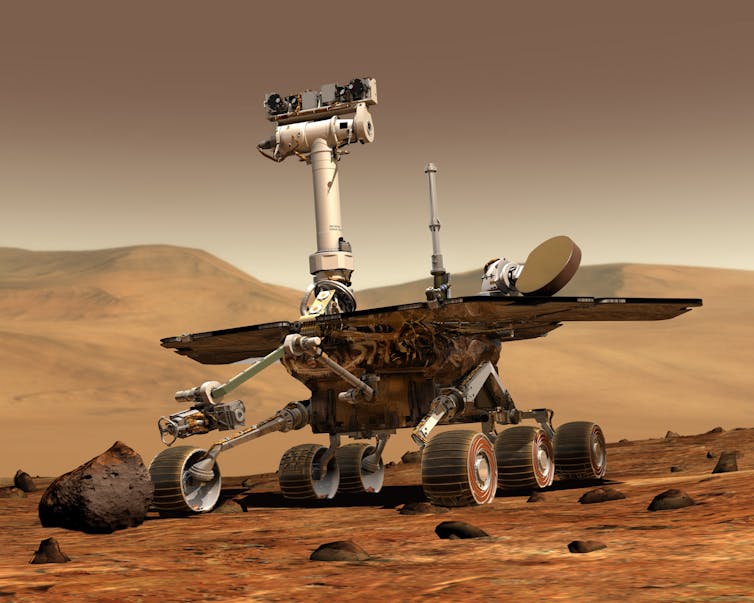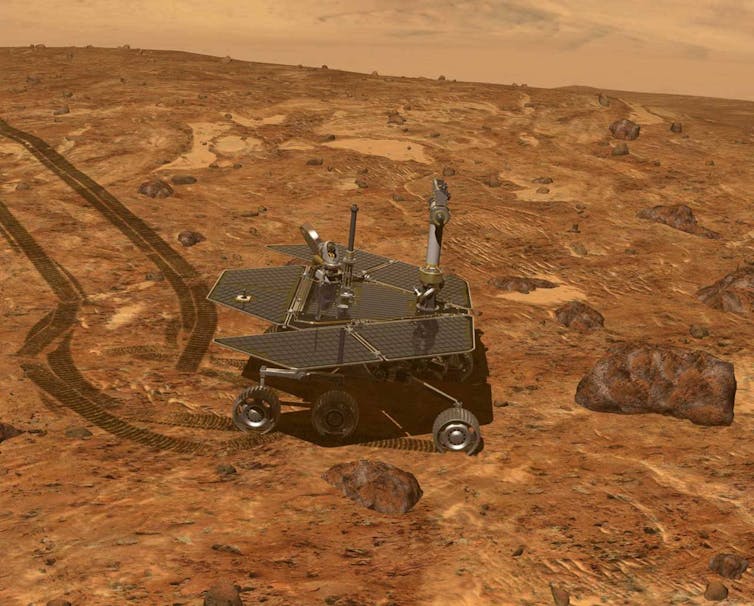What are some of the challenges to Mars travel?
- Written by Paulo de Souza, Science Leader – Sensor Networks, CSIRO
Curious Kids is a series for children. If you have a question you’d like an expert to answer, send it to curiouskids@theconversation.edu.au You might also like the podcast Imagine This, a co-production between ABC KIDS listen and The Conversation, based on Curious Kids.
What are some of the challenges humans will face as we make plans to travel to and explore Mars? – Lynlee, age 10, Arlington, Tennessee.
Hi Lynlee. You’re not the only one wondering what a trip to Mars might be like. Elon Musk, a US businessman who has a company called SpaceX, said his spaceship will be ready for short trips to the red planet by 2019.
Meanwhile, the Mars One project, run by a Dutch company, aims to build a permanent human settlement on Mars.
I’ve worked as a collaborating scientist with NASA’s Mars Exploration Rover Project for the past 16 years. If you managed to get yourself a ticket to Mars on a spaceship, here’s how I’d advise you to prepare.
 An artist’s concept portrays a NASA Mars Exploration Rover on the surface of Mars.
NASA/JPL, CC BY
An artist’s concept portrays a NASA Mars Exploration Rover on the surface of Mars.
NASA/JPL, CC BY
Read more: An Opportunity for life: finding Mars' most liveable mud
The journey to Mars
You might be travelling with other astronauts in a journey that will take between seven and 12 months, packed in a tight space. So you’ll need to stretch and probably find a way to have part of the spacecraft spinning to create artificial gravity. Having no gravity for a long time can cause a lot of painful health problems for astronauts.
Then there’s the powerful cosmic radiation that comes mostly from our Sun. It can damage electronic equipment on board and create health problems for the crew. You and the crew will have to solve these problems on your own.
You must know every detail of the spacecraft inside out and draw on your extensive astronaut training to fix problems using only what you brought with you. You may have to 3D print spare parts from materials like titanium (using tech invented by Australia’s national science agency CSIRO).
You’ll probably also need stuff like carbon fibre, printable solar cells, 3D mapping, robotics and cybersecurity technology. The good news for you is that CSIRO (where I work) is tackling this with its new space roadmap.
Communication will be difficult. Expect any message you send to Earth to take 20 minutes to reach its destination. Video conferencing will not be possible. Social media is still accessible, but tweets or Facebook posts will take 20 minutes to appear and responses from Earth will take up to 40 minutes to arrive.
Life on Mars
If you make it to Mars, the real challenge begins. Gravity on Mars is a fraction of what it is on Earth so everything will seem very light. A thing that weighed 100kg on Earth would weigh just 38kg on Mars.
You will need to live in Mars’ punishing environment. Dust storms with winds reaching 400km/h could leave you in the dark for several weeks. It’s mostly pretty cold. The temperature variation between day and night is in excess of 120℃.
The atmosphere is not breathable: it is only 1% the thickness of our atmosphere, mostly made of carbon dioxide, argon, and nitrogen with only a small amount of oxygen.
The most interesting challenge, in my opinion, is the Martian day (also known as “sol”). It is around 40 minutes longer than a day on Earth. I had the privilege of working with the Mars rovers Spirit and Opportunity and whilst doing that I had to live on Martian time.
I arrived at NASA’s Jet Propulsion Laboratory every day at 8am (on Martian time). If that was 8am in California, then the next day I had to arrive 8:40am, then 9:20am, 10am, 10:40am. It was like having a summer daylight savings every single day.
 Here’s a Mars Rover. Scientists on Earth can control and drive it along Mars’ surface to inspect geological features.
NASA/JPL, CC BY
Here’s a Mars Rover. Scientists on Earth can control and drive it along Mars’ surface to inspect geological features.
NASA/JPL, CC BY
Growing plants on Mars is not going to be easy. The soil is really salty and acidic. It is still unclear if we should bring bacteria to Mars to help plants grow (as they do on Earth).
Finally, I would say any mistake in flight or during the exploration can hurt or kill you. The room for error is really narrow.
Why on Earth would you engage in such a dangerous, life-threatening endeavour?
I guess the answer lies in what has made humans explore throughout the centuries. We are always looking for the next frontier.
Read more: Curious Kids: What plants could grow in the Goldilocks zone of space?
Hello, curious kids! Have you got a question you’d like an expert to answer? Ask an adult to send your question to us. They can:
* Email your question to curiouskids@theconversation.edu.au * Tell us on Twitter
 CC BY-ND
Please tell us your name, age and which city you live in. You can send an audio recording of your question too, if you want. Send as many questions as you like! We won’t be able to answer every question but we will do our best.
CC BY-ND
Please tell us your name, age and which city you live in. You can send an audio recording of your question too, if you want. Send as many questions as you like! We won’t be able to answer every question but we will do our best.
Authors: Paulo de Souza, Science Leader – Sensor Networks, CSIRO
Read more http://theconversation.com/curious-kids-what-are-some-of-the-challenges-to-mars-travel-105030





